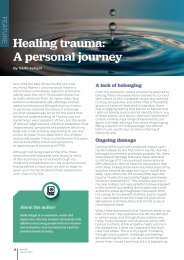ACC Accord Summer 2021 Issue 111
Create successful ePaper yourself
Turn your PDF publications into a flip-book with our unique Google optimized e-Paper software.
Can we predict the types<br />
of people who are more<br />
likely to hold a positive or<br />
negative attitude towards<br />
children with autism?<br />
by Anne Franks<br />
“Autistic Spectrum Disorder<br />
(ASD) is a developmental disorder<br />
affecting an individual’s social<br />
interactions and the way they<br />
experience the world around them”<br />
(The National Autistic Society, 2018).<br />
In the UK there are currently<br />
around 700,000 individuals<br />
diagnosed with ASD, which<br />
accounts for over 1 in 100 people (1).<br />
However, the experiences of those<br />
with ASD can sometimes be quite<br />
challenging. For instance, one in<br />
three autistic adults experience<br />
mental health difficulties and only<br />
32% of autistic adults have a paid<br />
job, with just 16% in full-time paid<br />
employment (1). Furthermore,<br />
these difficulties can sometimes<br />
even start in childhood, with 34% of<br />
children with ASD claiming that the<br />
worst thing about being at school is<br />
being picked on, and 63% of autistic<br />
children not being in the kind of<br />
school their parents feel would best<br />
support them (1).<br />
Given the difficulties faced by<br />
children with ASD, it is important<br />
to better understand some of<br />
the ways in which this diagnosis<br />
will affect them – particularly the<br />
attitudes of the people around<br />
them who play a huge role in<br />
shaping their experiences (Jorm,<br />
2000). In fact, a lot of research has<br />
now been conducted on this area<br />
with multiple studies focusing on<br />
the attitudes of teachers towards<br />
children with ASD (Park and<br />
Chitiyo, 2010; Linton et al., 2013;<br />
Cassidy, 2011). For example, Park<br />
and Chitiyo (2010) used the Autism<br />
Attitude Scale for Teachers (AAST)<br />
to compare teachers’ attitudes<br />
across different variables such as<br />
gender, age of the teacher, age or<br />
level of the students they teach and<br />
the teacher’s knowledge of autism<br />
to see if any of these factors could<br />
be predictors of whether teachers<br />
would be more or less likely to hold<br />
a positive attitude towards autistic<br />
children. In line with other literature<br />
(Horrocks et al., 2008; Tilahun et al.,<br />
2018), they found that teachers who<br />
had attended autism workshops<br />
had more positive attitudes<br />
towards children with autism than<br />
those who had not. The researchers<br />
also found that the oldest age<br />
category (56 years and older)<br />
demonstrated the lowest levels of<br />
positive attitude towards children<br />
with autism. Lastly, they also found<br />
that female teachers displayed<br />
more positive attitudes than male<br />
ones, although, the gender ratio<br />
was very biased with just 9% of<br />
participants being male (Park and<br />
Chitiyo, 2010, pp. 71).<br />
However, there are a number of<br />
important limitations with the<br />
existing research. For instance, the<br />
majority of the literature comparing<br />
attitudes towards autism across<br />
gender tends to be dominated<br />
by female participants (Dachez<br />
et al. 2015; Park and Chitiyo, 2010),<br />
meaning that there are often so<br />
few male participants that the<br />
results cannot really be generalised.<br />
Additionally, much of the existing<br />
research on attitudes towards<br />
autism is focused only on teachers’<br />
attitudes. However, given that<br />
children with autism are integrated<br />
in much broader social networks<br />
within society than schools alone,<br />
I thought it was important to<br />
investigate the various factors<br />
which might predict attitudes held<br />
by the general population towards<br />
children with ASD, concentrating<br />
on four predictive factors which<br />
have previously been highlighted<br />
by similar attitude studies: age,<br />
gender, knowledge about ASD<br />
and lastly the amount of social<br />
interaction with children with ASD.<br />
I recruited 202 participants (100<br />
28 accord <strong>Summer</strong> <strong>2021</strong> www.acc-uk.org • www.pastoralcareuk.org



